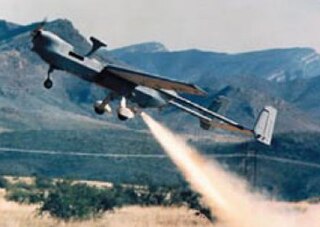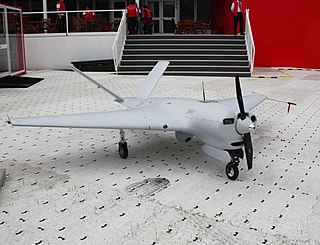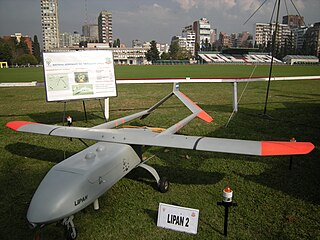
The IAI RQ-5 Hunter unmanned aerial vehicle (UAV) was originally intended to serve as the United States Army's Short Range UAV system for division and corps commanders. It took off and landed on runways. It used a gimbaled EO/IR sensor to relay its video in real time via a second airborne Hunter over a C-band line-of-sight data link. The RQ-5 is based on the Hunter UAV that was developed by Israel Aerospace Industries.

The Alliant RQ-6 Outrider unmanned aerial vehicle (UAV) was designed to provide near-real-time reconnaissance, surveillance, and target acquisition information to United States Marine Corps air/ground task forces, United States Army brigades, and deployed United States Navy units that was small enough for an entire system to be contained on two Humvees and trailer and transported on a single C-130 Hercules cargo aircraft.

The Sikorsky Cypher and Cypher II are types of unmanned aerial vehicles developed by Sikorsky Aircraft. They are vertical takeoff and landing aircraft which use two opposing rotors enclosed in a circular shroud for propulsion.
The EADS 3 Sigma Nearchos is a medium distance reconnaissance unmanned aerial vehicle (UAV) introduced in 1996, one of several UAVs developed by the Greek 3 Sigma aerospace company, in collaboration with Greek universities.
The Yarará project is the first unmanned aerial vehicle (UAV) programme in South America to be produced in series and for export. The system is developed by Nostromo Defensa for surveillance, border patrol and reconnaissance. It was unveiled at the Argentine Air Force Air Show on 10 August 2006. The manufacturer says it has been produced in small series for export to an unidentified government customer in the United States.

The DRDO Nishant - is an unmanned aerial vehicle (UAV) developed by India's Aeronautical Development Establishment (ADE), a branch of Defence Research and Development Organisation (DRDO) for the Indian Armed Forces. The Nishant UAV is primarily tasked with intelligence gathering over enemy territory and also for reconnaissance, training, surveillance, target designation, artillery fire correction, damage assessment, ELINT and SIGINT. The UAV has an endurance of four hours and thirty minutes. Nishant has completed development phase and user trials.

The Elbit Systems Skylark I and Skylark II are miniature UAVs developed by Elbit Systems. Initial models of the Skylark entered service in 2008.

The DRS Sentry HP is a reconnaissance UAV that was developed in the United States in the late 1980s by S-TEC. The program was acquired by Meggitt in 2000 and subsequently by DRS in 2002. Although the aircraft shares the name "Sentry" with a previous S-TEC design, the Sentry HP is a completely different machine, with a broad wing and a V tail. The Sentry HP is larger, with greater payload capacity and an underwing stores capability. It is powered by a variant of the same engine as the Sentry. It can be ordered with an option for fixed landing gear to permit conventional takeoff and recovery.

The DRS RQ-15 Neptune is a reconnaissance UAV developed in the United States in the early years of the 21st century. The design is optimized for operations over water, and is capable of water landings on its flying boat–like hull. The 11.2 kW (15 hp) pusher engine is mounted high to keep it dry during takeoffs and landings. The Neptune can also be launched off a pneumatic catapult and land on a skid. In 2007, one was unsuccessfully launched off the USS Nashville (LPD-13), crashing into the water less than two seconds after lift off.

The AeroVironment Wasp III Small Unmanned Aircraft System is a miniature UAV developed for United States Air Force special operations to provide a small, light-weight vehicle to provide beyond-line-of-sight situation awareness. The aircraft is equipped with two on-board cameras to provide real-time intelligence to its operators. It is also equipped with GPS and an Inertial Navigation System enabling it to operate autonomously from takeoff to recovery. It was designed by AeroVironment Inc., and was first added to the Air Force inventory in 2007. There are two Wasp variants: the traditional version that lands on land, and a version that lands into the sea or fresh water. The Air Force accepted the Wasp AE in late May 2012, and the U.S. Marine Corps revealed in January 2013 that they had ordered the Wasp AE. The Wasp AE is designated as the RQ-12A.
Kapothaka was a technology demonstrator mini-UAV for reconnaissance. The Kapothaka which means “dove” is believed to be a predecessor of Nishant UAV system.
The BZK-005 Medium-altitude, long-range UAV is a reconnaissance aircraft designed by Harbin Aircraft Industry Group. It is used by the PLA Navy and PLA Air Force.

The BPL Pegaz 011 is a tactical unmanned aerial vehicle prototype developed at the Military Engineering Institute, premiered at the 2011 Partner Arms Fair.
TAI Keklik is a radio-controlled tracking target drone introduced in 2001. Designed, developed and built by Turkish Aerospace Industries (TAI), the unmanned aerial vehicle (UAV) is in use by the Turkish Armed Forces for target tracking in non-firing gunnery exercises.

TAI Gözcü is a radio-controlled short-range tactical drone. Designed, developed and built by Turkish Aerospace Industries (TAI), the unmanned aerial vehicle (UAV) is in use by the Turkish Armed Forces for intelligence, surveillance, target acquisition and reconnaissance purposes. Gözcü is the Turkish word for observer.

The HESA Hamaseh is an Iranian tactical and reconnaissance unmanned aerial vehicle (UAV) with high flight endurance built by Iran Aircraft Manufacturing Industrial Company (HESA). The Hamaseh was unveiled in 2013 and entered service in 2016.
ASN-209 UAV and its derivative are Chinese UAVs developed by Xi'an Aisheng Technology Group Co., Ltd (西安爱生技术集团公司)ASN Technology Group Co., Ltd (西安爱生技术集团公司), also known as Northwestern Polytechnical University UAV Research Institute or 365th Institute, established in 1984.

The Lipan M3 is a surveillance, reconnaissance and intelligence unmanned aerial vehicle (UAV) developed by Ejército Argentino since 1996. The Lipan M3 is also the first UAV developed in Latin America.

The Wing Loong-10 is a series of unmanned aerial vehicles of the High-Altitude Long Endurance (HALE) type, featuring some stealth characteristics. As of 2017, it is being developed by the Chengdu Aircraft Industry Group for reconnaissance and precision strike missions.

The KAI RQ-101 Songgolmae is a South Korean military unmanned aerial vehicle (UAV) developed by the Agency for Defense Development (ADD) and the Korea Aerospace Industries (KAI) in 2000. RQ-101 is an unarmed UAV designed for corps commanders and has been deployed and serviced by the South Korean Army since 2002 to collect military intelligence. It was officially given the name Songgolmae.














